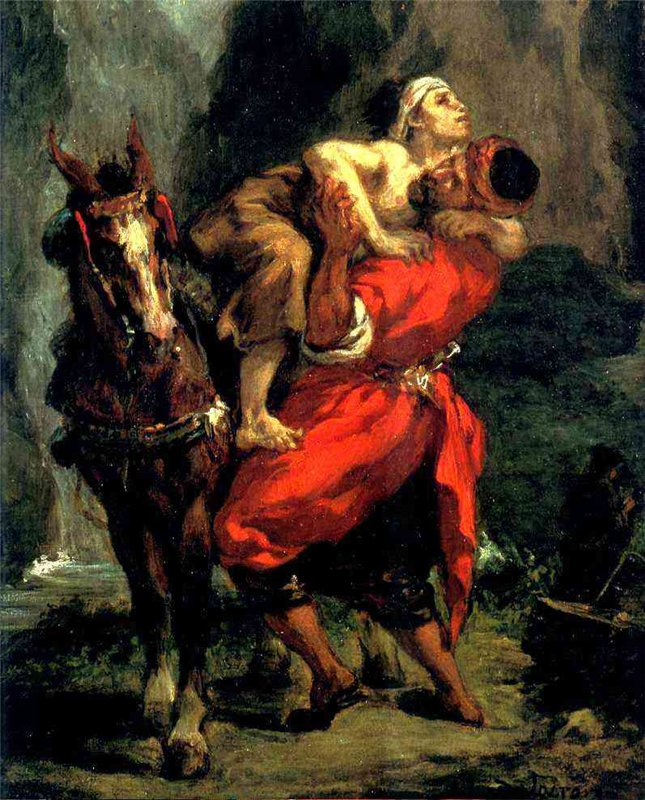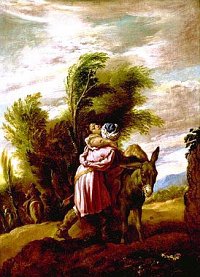ArtsVanGogh.com
Vincent van Gogh 1853-1890
Vincent van Gogh - The Good Samaritan after Eugène Delacroix 1890
/133 The Good Samaritan after Delacroix.jpg) The Good Samaritan after Eugène Delacroix |
 The Good Samaritan |
The Letters of Vincent van Gogh
To Willemien van Gogh. Saint-Rémy-de-Provence, Monday, 9 or Tuesday, 10 December 1889.
My dear sister,
Thanks very much for writing to me. Myself, I’d be very pleased if you went to Theo’s in January – as it isn’t impossible that I too may go to Paris, we may meet. The description of your and Mother’s new dwelling interests me a great deal, and this move is indeed a wise and well-considered arrangement. It would certainly charm me if I saw it, this quay where people come to wash green and red wool with the small barges and vessels moored, and the factory with its windows lit up in the evening. Those are effects that I would paint.
And the garden too, with its espalier mulberry tree. As regards mulberry trees, there are a lot here. I painted one not long ago when its bushy foliage was a magnificent yellow against a very blue sky and a white, stony, sunlit field behind.
I’m planning to send to Brussels sunflowers, a completely red vineyard in the autumn, an orchard in blossom, tree-trunks covered with ivy, and finally a field of young wheat in the rising sun. I’m working on this last canvas at the moment, it is (with the orchard in blossom, which Theo liked, from what he was saying) the gentlest thing I’ve painted. The fleeing lines of the furrows rise high into the canvas towards a background of purplish hills. The earth is pink and violet marbled with the yellow-green of the wheat. The sky in the background with a sun is pale lemon yellow and pink.
Above all, don’t imagine that it’s less cold here than in Holland, the winter has only just begun and we’ll have it until the end of March. Only less rain than in Holland, very cold, unbearably irritating wind, and cold spells that are dry and bright but severe all the same, although the sun has more strength and the sky is very blue.
You will receive soon, I think, the canvases I promised you. What I find very unfortunate is that you write that Jo says that Theo’s still coughing the whole time – blast – that doesn’t please me – however, I still hope that when he’s a father it’ll get better. I’d like him to have my health, in this sense that I myself always have lots of life in the fresh air, and he’s always always at his desk with so many troubles on his mind.
And they’re wicked at Boussods’, too full of pride and tyrannical.
I have 12 large canvases on the go, above all olive groves, one with an entirely pink sky, another with a green and orange sky, a third with a big yellow sun.
Then tall, ravaged pines against a red sunset sky. I’ve just received a very kind letter from Theo, he says that Jo and he are well, and he also says that you’ll perhaps come to them. Let’s keep hoping that in a while his health will completely recover – with him, the state of his mind greatly influences the rest. At the moment many painters who spent the winter in the countryside are returning to Paris. You ask who Bernard is – he’s a young painter – he’s twenty at most. Very original. He seeks to do modern figures as elegant as ancient Greeks or Egyptians. A grace in the expressive movements, a charm through daring colours. I saw a Sunday afternoon in Brittany by him , Breton peasant women, peasants, dogs strolling in a very green meadow, the costumes are black and red, and big white caps.
But in this crowd there are also two ladies, one in red, the other in bottle green, who make it into a really modern thing.
Ask Theo to show you the watercolour I did after the painting, it was so original that I wanted to have a copy of it.
Now you think you remember having seen some rocks by him, he’s done a lot of them, and cliffs and beaches in Brittany.
He’s also done landscapes and figures of the Paris suburbs. Theo has an excellent thing of his which I exchanged with Bernard for a canvas of mine. It’s the portrait of his very old grandmother, one-eyed, the background is a bedroom wall covered with chocolate-coloured wallpaper, and a completely white bed.
He’s just sent me 6 photographs of paintings he’s done this year, and by contrast they are bizarre biblical subjects and very open to criticism. But you can see from this that he’s a curious fellow, a seeker who tries everything. It’s like tapestries from the Middle Ages: stiff, brightly coloured figures. But I have only a mediocre admiration for this, because the English Pre-Raphaelites did those things with more seriousness and conscientiousness and knowledge and logic. Thus you may know Millais who did The Huguenot and an engraving, The light of the world. If you wanted I could tell Bernard to do your portrait when you’re in Paris, he’d certainly do it, and very well I can assure you, I wouldn’t speak to him about it if it would displease you, but I myself would very much like him to do it. And I would exchange it for a painting of mine he wants me to exchange.
While writing this letter I got to my feet to go and give a few brushstrokes to a canvas in progress – specifically, it’s the one with the ravaged pines against a red, orange, yellow sky – yesterday it was very fresh – pure, dazzling tones – well while writing to you I don’t know what thoughts came to me, and upon looking at my canvas I told myself, that’s not it. So I took a colour that appears as matt, dirty white on the palette, which one obtains by mixing white, green and a little carmine, I slashed this green tone all over the sky, and there you are, from a distance it softens the tones by breaking them up. And yet it would seem that one spoils and dirties the canvas. Do misfortune and sickness not do this with us and our health, and are we not worth more just as we are, in fate, the great destiny that carries us away, than serene and well according to our own vague ideas and desires of possible happiness? I don’t know.
Some of my paintings, when I compare them to others, certainly do bear the trace that it’s a sick man who paints them, and I can assure you that I don’t do it deliberately. But despite myself, my calculations end up at broken tones. Bernard has parents who grudgingly house and feed him, often reproaching him for still not earning money. So the house there is sometimes a hell, but no one works so much with so few expenses to my knowledge. Anyway he’s a fine, really Parisian boy, very elegant. He was to go off to be a soldier this year, but for health reasons it has been postponed to next year.
I must go and work some more, more soon, I kiss you affectionately in thought.
Ever yours,
Vincent
